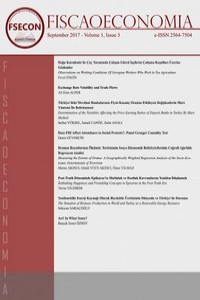Öz
Kaynakça
- 1. Arthur C. Danto, After the End of Art: Contemporary Art and the Pale of History, Princeton University Press, 1997.
- 2. Arthur C. Danto, The Philosophical Disenfranchisement of Art, New York, Columbia University Press, 1986.
- 3. Clement Greenberg, “Counter-Avant Garde” Art International 15 (May 1971).
- 4. Clement Greenberg, “The Case for Abstract Art”, in Collected Essays and Criticism, Volume IV, The University of Chicago Press, 1959.
- 5. Mark Rollins (ed.), Danto and His Critics, Malden, MA: Wiley-Blackwell, 2012.
- 6. Noel Carroll, “Danto’s New Definition of Art and the Problem of Art Theories” in British Journal of Aesthetics, Vol. 37, No. 4, 1997.
- 7. G. W. F. Hegel, Aesthetics: Lectures on Fine Art, transl. T. M. Knox, Oxford, 1975.
- 8. Peter Lamarque and Stein Haugom Olsen, (eds.), Aesthetics and the Philosophy of Art, Malden, MA: Blackwell Publication, 2004.
Öz
This paper is a critique of the conception of
art which is mainly based on Arthur Danto’s definition of art via Hegelian aesthetics.
In 1964, when Danto encountered with Andy Warhol’s Brillo Box a renewed era
for the definition of art has come. For Hegel one of the most crucial criteria for
art-work is its indispensible adequacy between content and presentation. Although
Danto as a philosopher is so much Hegelian by the time of modern art there
emerges a historical shift within art and this article tries to reveal how Danto
departs from Hegel through the philosophical question of what makes any work an
art-work. When there renders no ‘bodily’ distinction between content and
presentation, there emerges an essential question: According to what one of the Brillo boxes inside a grocery
store is just an ordinary box while the other one is such a precious artwork in
Soho Gallery.
Kaynakça
- 1. Arthur C. Danto, After the End of Art: Contemporary Art and the Pale of History, Princeton University Press, 1997.
- 2. Arthur C. Danto, The Philosophical Disenfranchisement of Art, New York, Columbia University Press, 1986.
- 3. Clement Greenberg, “Counter-Avant Garde” Art International 15 (May 1971).
- 4. Clement Greenberg, “The Case for Abstract Art”, in Collected Essays and Criticism, Volume IV, The University of Chicago Press, 1959.
- 5. Mark Rollins (ed.), Danto and His Critics, Malden, MA: Wiley-Blackwell, 2012.
- 6. Noel Carroll, “Danto’s New Definition of Art and the Problem of Art Theories” in British Journal of Aesthetics, Vol. 37, No. 4, 1997.
- 7. G. W. F. Hegel, Aesthetics: Lectures on Fine Art, transl. T. M. Knox, Oxford, 1975.
- 8. Peter Lamarque and Stein Haugom Olsen, (eds.), Aesthetics and the Philosophy of Art, Malden, MA: Blackwell Publication, 2004.
Ayrıntılar
| Konular | İşletme |
|---|---|
| Bölüm | Makaleler |
| Yazarlar | |
| Yayımlanma Tarihi | 30 Eylül 2017 |
| Yayımlandığı Sayı | Yıl 2017 Cilt: 1 Sayı: 3 |
Fiscaoeconomia is licensed under a Creative Commons Attribution-NonCommercial-ShareAlike 4.0 International License.


